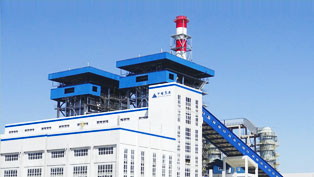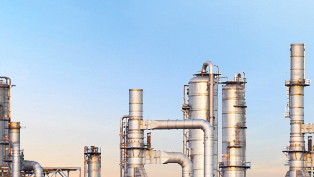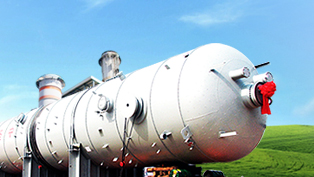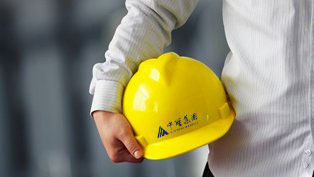-
01High Efficiency Heat Transfer Technology +
In the fields of petroleum, chemical, metallurgy, thermal power and other engineering fields, shell-and-tube heat exchangers are widely used in the evaporation, condensation, heating and cooling of materials. Low heat transfer efficiency, large volume, and high operating cost are common shortcomings of normal shell-and-tube heat exchangers. By replacing the smooth tube with a high-efficiency special heat exchange tube, the heat transfer efficiency of the heat exchanger can be significantly improved, the weight of the equipment can be reduced, the space occupied can be reduced, energy can be saved, and the cost can be reduced. While improving heat transfer efficiency, the special geometry of the special tube has self-cleaning effect, making the heat exchange surface less prone to fouling, thus extending the equipment operating cycle. In addition, combined with some special shell-side design, such as the use of baffle rods, spiral baffles in the shell process, reducing the pressure drop, the shell-side heat transfer efficiency is further improved, anti-fouling ability is further enhanced. Therefore, high-efficiency heat exchangers have great advantages in energy-saving renovation, capacity expansion and localization of imported equipment.
Jiangsu Sunpower has developed a variety of high-efficiency heat exchangers, including T-groove tube high-efficiency heat exchangers, high-efficiency heat exchangers for internal-bellow external-threaded tubes, high-efficiency heat exchangers for corrugated tubes, high-efficiency heat exchangers for inner groove tubes, and twisted tubes high efficiency heat exchanger, low finned tube high efficiency heat exchanger, high finned tube high efficiency heat exchanger, coiled high efficiency heat exchanger, high flux tube efficient heat exchanger, hairpin type high efficiency heat exchanger, spiral baffle Plate efficient heat exchanger, spiral plate efficient heat exchanger, baffle rod efficient heat exchanger, low temperature hot rod, etc., and obtained a number of national patents. These high efficiency heat exchange equipment can be used for a variety of single phase, boiling, condensation heat transfer. The high-efficiency heat exchanger manufactured by the company has high heat transfer efficiency, stable operation, large elasticity and long service life. It has been widely used and praised by large enterprises such as Yangzi Petrochemical, Shanghai Petrochemical and Baosteel, and exported to Russia and other countries.
• High efficiency heat transfer technology: Sunpower is one of the few manufacturers in China that can design and produce independently
• Cold hydrogenation reactor design and manufacturing technology in the field of polysilicon: the first in domestic performance, leading domestic products
• Reduction furnace design and manufacturing technology in the field of electronic grade polysilicon: the only manufacturer in China
• Solar-grade polysilicon reduction furnace design and manufacturing technology: with independent research and development design and manufacturing capabilities, leading domestic
• Core reactor, heat exchanger design and manufacturing technology in petrochemical and refining projects: leading domestic
• Three types of LNG vaporizers: the only manufacturer in China that can design and manufacture completely independently and have a successful operation.
-
02Flare and flare gas recovery technology +
Sunpower specializes in all kinds of industrial waste gas treatment, especially the complete turnkey engineering services of design, equipment manufacturing and system installation for flare gas combustion emission and recovery system. Adhere to the provision of intrinsically safe flare gas treatment and recovery system, through reasonable system organization, advanced and mature combustion technology, and reliable control means to recover the maximum amount of flare gas, the flare gas treatment device can meet normal production or water stoppage and power failure. Discharge requirements for accidents such as shutdown, fire, etc., burning and discharging in the flare device in a timely, safe and reliable manner; under any working conditions, the back pressure generated by the flare gas combustion and recovery system does not affect the safe discharge of the flare gas of the process device. The ground heat radiation intensity and the unburned combustion products discharge concentration of the hazardous materials meet the requirements of environmental protection; the flare can be stably switched without being affected by external conditions between the predetermined maximum and minimum emissions; the utilities consumption is economic and reasonable. Sunpower has already built 130 sets (sets) flares, especially in the coal chemical large-scale flare system, which already accounts for 80% of the domestic market.
The flare gas recovery system developed by Sunpower reduced the environmental pollution caused by flare gas combustion emissions. It was appraised by Sinopec and the State Environmental Protection Administration for scientific and technological achievements. It was rated as “National Key Environmental Protection Practical Technology Demonstration Project” and was listed as “ The national key environmental protection new products are widely used in enterprises such as Sinopec, PetroChina and China Shenhua.
In 2016, Sunpower flare passed the EFA certification of SHELL, becoming the only flare EFA supplier in SHELL in Asia, laying the foundation for more international markets.
-
03Zero Liquid Discharge Technology +
On the basis of digesting and absorbing the ZLD evaporation crystallization technology of mature high-salt wastewater from foreign companies, based on the technical advantages of Sunpower itself in efficient heat transfer, equipment manufacturing and water treatment engineering, Sunpower has developed a high-efficiency membrane concentration technology, Evaporation crystallization technology, and salt recycling technology as a whole, low-energy, non-discharge hazardous substances, high-salt wastewater zero-discharge completed process technology.
Advanced technology:①According to the water quality characteristics of domestic wastewater and the demand for zero-discharge technology, develop a high-salt wastewater zero- discharge process that combines the use of waste heat, high-efficiency evaporation crystallization technology, and separate salts recovery technology and packaged equipment, to effectively reduce construction costs and operating costs. ② In the case of no waste heat utilization in the factory, the application of mechanical vapor compression (MVC) technology in the zero discharge of domestic wastewater has been developed, which greatly reduces operating costs. ③ In the process of detoxifying the solid crystalline salt produced by the zero-discharge process of high-salt wastewater, industrial salt such as sodium sulfate or sodium chloride meeting industrial grade requirements is obtained. ④ Combine the pilot test and process simulation to develop a zero-emission full-process technology for low-energy, high-salt wastewater that does not emit harmful environmental pollutants, and form a process package.
The zero-discharge system developed by the Group has effectively solved the major technical problems of zero discharge of high-salt wastewater in coal chemical, petrochemical, electric power and other industries, and utilized waste gas resources. The Shenhua Coal-to-Oil High-Salt Wastewater Treatment and Reuse Project, which was EPC contracted by Sunpower Group, is the first successful high-salt wastewater treatment project in China, and was rated as “Excellent Project” by Shenhua. Promote the application of home enterprises.
-
04Clean energy green investment know-how +
High-efficiency boiler and flue gas waste heat recovery system:including high-efficiency boiler, low-temperature economizer system, low-temperature flue gas heat exchange system GGH, low-temperature flue gas waste heat recovery system. Through the system, high-efficiency combustion can be achieved, the burn-up rate is over 93%, the thermal efficiency is increased by about 30% compared with the conventional boiler, and the exhaust gas temperature can be reduced by one-third, the dust removal efficiency is improved, and the power consumption and operation cost are reduced.
Green energy-saving ammonia desulfurization technology:including flue gas system, absorption system and ammonium sulfate system. The technology can achieve sulfur dioxide emissions below 35mg/Nm3, and the emission index is far below the national standard. Under the premise of sulfur dioxide emission standards, sulfur dioxide pollutants can be converted into a saleable compound fertilizer ammonium sulfate to realize waste resource utilization。
Steam low-energy-consumption long-distance transportation technology:Sunpower is the first technical service provider in China to provide comprehensive energy-saving solutions for steam low-energy-consumption long-distance transportation. With more than 20 years of rich experience and engineering achievements, it has proprietary insulated pipe support and composite insulation technology. 20% of energy consumption (temperature, pressure) during steam transportation is caused by pipe transfer. With the long-distance adiabatic conveying system of Sunpower Steam Pipe Network, and the temperature drop is reduced from 15 °C/Km to 3-5 °C. /Km, the pressure difference drops by one-third, and the conveying radius can be extended from the conventional 8Km to 30Km, serving more enterprises. 80% of the pipeline loss is recovered, which provides guarantee for energy saving and production increase.
Ash slag system:It adopts high-efficiency boiler with high burning rate. The ash contains less than 1.5% carbon. It can be used to make coal powder ash cement, sintered brick, roadbed and asphalt pavement additives, etc., and becomes a saleable product.
Relying on the above proprietary technology, the company can cooperate with the wastewater treatment plant in the park to use sludge as boiler fuel, partially replace coal, reducing coal consumption; fully recycle and use recycled water (middle water), which will be directly discharged at present. Reclaimed water is used as a water source to produce steam, reducing the consumption of fresh water; it can provide preferential power and long-distance pipeline steam to the surrounding enterprises of the park, reducing their cost; can realize the near-zero emission of burned slag bricks, and can adopt advanced The ammonia desulfurization and environmental protection technology almost completely eliminates the dust, sulfur dioxide and nitrogen oxides in the exhaust gas of the boiler to achieve clean heating.
-
05Comprehensive Utilization of LNG Cold Energy +
Sunpower Group can provide LNG gasifier, coiled tube heat exchanger, composite cold insulation material, and integrated solution for cold energy comprehensive utilization. It can not only meet the requirements of process such as ice making, freezing, refrigeration, fresh-keeping, air separation, circulating water cooling, seawater desalination, light hydrocarbon separation, low temperature crushing, dry ice manufacturing, etc., without affecting the LNG receiving station's natural gas transmission, but also generate electricity through the Rankine cycle process, making full use of LNG cooling energy.
Sunpower Technical Advantages:
• Make full use of LNG cooling energy to improve cooling energy efficiency
• Mainly supplying gas, taking into account power generation and cold storage refrigeration, ensuring that LNG gas supply is not affected
• The core key equipment is independently developed and manufactured to ensure the system operation effect.
• Steam low energy consumption and long distance conveying technology
-
06High Efficiency Heat Rod Technology +
Sunpower Group is the first company in the world to promote heat rod technology for the treatment of frozen soil. The frozen soil treatment technology independently developed by the company, the low temperature heat rod, successfully solved the problems that have plagued Chinese scientists and Qinghai-Tibet Railway builders for many years. The major technical problem is the instability of the permafrost in the Qinghai-Tibet Railway subgrade for the melt down in summer and the frost heaving in winter. The product has been fully affirmed by the Chinese Academy of Sciences and the Qinghai-Tibet Railway Expert Group and designated as the only technical reserve for the Qinghai-Tibet Railway's freeze damage treatment. Sunpower is the undertaker of the Nanjing Frozen Soil Engineering Center of the Chinese Academy of Sciences and the heat rod working group of the National Traffic Engineering Facilities Standardization Technical Committee, and leads the drafting of national standards: "Heat Rod" (GB/T 27880-2011), "Heat Rod Pipe Rack" (GB/T 31259-2014). The company's heat rod standard won the "China Standard Innovation Contribution Award" and has a number of national invention patent technologies. The technology passed the expert appraisal meeting organized by the Science and Technology Department of Jiangsu Province, and won the second prize of the State Education Commission, the China Petroleum and Chemical Federation, and the Jiangsu Science and Technology Progress Award.
Through the single-direction cold transfer of the hot rod, a large amount of cold is stored in the underground frozen soil layer in winter, and the frozen soil is not melted in the summer to form a "permafrost layer", which improves the strength of the frozen soil; preventing roadbed's railways and highways from sinking during operation. This technology is widely used to solve the worldwide problems of the permafrost deformation of major national projects such as the Qinghai-Tibet Railway, Qinghai-Tibet Highway, Sino-Russian oil pipelines, and in the construction of infrastructure such as bridges, culverts, tunnels, airstrips, and oil pipelines.
Nano-hot rod technology independently developed by Sunpower Group (fifth-generation hot rod):through the vibration of molecular vibration, the dark infrared radiation area is formed in the 60cm diameter around the hot rod, which has the characteristics of fast heat generation, stable heat generation, etc. 2-5 times thermal efficiency, energy saving 50%- 80%.
-
07Heat pipe and waste heat recovery technology +
The company is the main drafting unit of the national standard "non-die heat pipe". The company has four corporate standards: “carbon steel-water gravity heat pipe”, “high-frequency resistance welding spiral finned tube for heat pipe”, “medium temperature gravity heat pipe” and “low temperature gravity heat pipe”.
The company has been engaged in technical research and product research and development for more than 30 years. It has undertaken more than 20 scientific and technological projects in the National Torch Program, provincial and municipal departments, and conducted systematic and comprehensive research on heat pipe waste heat recovery technology for different application fields. A number of research results have been achieved, including a second prize of the National Science and Technology Progress Award, a first prize of the provincial science and technology progress, and two third prizes; 1 included in the National Science and Technology Plan, 1 National Torch Program, and 5 provincial and municipal science and technology plans.
Heat pipe technology: Heat pipe is a high-efficiency heat transfer element with a series of advantages such as high thermal conductivity, good isothermal temperature, long-distance heat transfer and temperature control.
Low-Low-temperature economizer technology: Low-low-temperature economizer is mainly used in the five major electric companies coal-fired boilers and the air preheaters of self-contained coal and gas boilers of various large enterprises to cool down the flue gas before the electric dust removal. Generally, the temperature of the flue gas at this position is in the range of 120-130 degrees. Actually, depending on the old and new efficiency of the boiler, the use is generally in the range of 130-190 degrees. Setting a low-temperature economizer here and reducing the temperature of the flue gas to 90 degrees into the electrostatic precipitator is an important process to meet the national ultra-low emission requirements. The benefits are three: 1. The flue gas temperature is reduced by 40 degrees, and the boiler power consumption is reduced. Coal is reduced by 2g standard coal/KWh (now 300MW is the minimum for pure coal-fired generating units, most of which are 600MW and 1000MW units); 2. The temperature of flue gas is reduced by 40 degrees, the volume flow of flue gas is reduced by more than 10%, the efficiency of electric dust removal is improved, and soot is reduced. The concentration is above 0.09% (the general four electric field dust collector can achieve the effect of the five electric field dust collector, and the emission is below 20mg/m3); 3. The water consumption of the desulfurization island is greatly reduced, and the general 300MW unit can save 40t/h of water.
This is also the reason why the state requires the five major power companies to set low-low temperature economizers for the ultra-low emission of existing and newly designed power station boilers, and the setting of low-temperature economizer is the only environmentally friendly process in all ultra-low emission processes.
• High heat transfer efficiency
• Effectively avoid the mixing of cold and hot fluids
• Effective control of low temperature dew point corrosion
• Effectively prevent dust accumulation
• No rotating parts, no additional power consumption, no need to change components frequently
Flexible metal enamel technology: on the basis of ordinary enamel, using the principle of fluidized pulverization kinetics, adding metal elements with corrosion resistance, its surface activity is improved at micro scale, and a strong chemical adsorption is formed with the fluxing compound and chemical bonding state to form a polymer. Significantly improve the strength, flexibility, wear resistance, corrosion resistance (water, oil, acid, alkali, salt), temperature resistance and anti-fouling properties of the metal enamel
The flexible metal enamel technology is improved on the basis of the original silicate enamel. The original silicate enamel has good anti-corrosion performance, but it has high brittleness, can't collide, can't have a large degree, and can't be fired on the fins; Chromium and high-nickel metals such as 317l, 2205, and titanium also have good anti-corrosion effects, but the cost is high. In order to solve the anti-corrosion of the heat exchange tube and ensure the cost performance, we use nanotechnology to burn a layer of nano-scale chromium, nickel and titanium materials on the surface of the heat exchange tube to improve the anti-corrosion performance of the heat exchange tube and reduce the heat exchange tube cost. This is widely used in the low-temperature dew point corrosion area of flue gas waste heat recovery, such as low-temperature economizer, GGH for ultra-low emission of power plant flue gas, gas pipeline of steel enterprise and heat exchange tube bundle of gas preheater.








